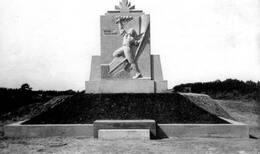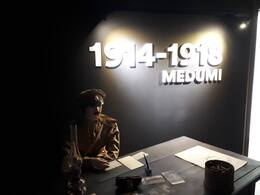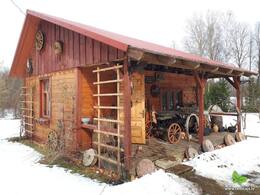World War I and the Wars of Independence in Southern Latvia
Day 5.
155 km
Jēkabpils - Viesīte - Svente - Medumi - Daugavpils
Practical info
- Maršruts ir domāts kā padomdevējs - kā optimālāk apceļot reģionu vai valsti, vai divas valstis ar mērķi iepazīt to militāro mantojumu;
- Braucējam pašam ir jāizplāno – cik no ieteiktajiem objektiem un vietām viņš vienas dienas laikā var iepazīt;
- Pirms ceļojuma ir jānoskaidro apskates vietu (muzeju, kolekciju, fortifikācijas u.c. objektu) darba laiks;
- Vietās, kur ir iepriekšēja pieteikšanās (vietējie gidi, privātas kolekcijas, cits), ir jāpiesaka vizīte, norādot datumu un laiku. Ja ceļojums tiek atcelts, ir jāinformē pieteiktās vietas;
- Naktsmītnes ir jārezervē laicīgi. Vasaras sezonā, īpaši jūras piekrastē naktsmītnes var būt nepieejamas. Daļa no ēdināšanas uzņēmumiem ziemas sezonā var nestrādāt;
- Ceļojumam izvēlieties ne tikai vasaru, bet arī citus gadalaikus;
- Latvijas – Lietuvas – Igaunijas robežas pa autoceļiem var šķērsot brīvi bez ierobežojumiem un jebkurā diennakts laikā. Iebraucot no vienas valsts otrā ir jābūt līdzi ID kartei vai pasei;
- Apmeklējiet tūrisma informācijas centrus, kur var iegūt papildus informāciju, bukletus, kartes.
Sights
Viesīte Freedom Monument
Viesīte Freedom Monument is a symbol of freedom, inde pendence and remembrance, dedicated to the battles of the defenders of Viesīte against the Bermontians in 1919.
On 14 October 1919, soldiers of the Third Jelgava Infantry Regiment, together with a unit of Viesīte-Sauka-Varenbroka home guards, stopped the attack of the Bermontians at Viesīte Vale Hill. As a result of this victory, the advance of Bermontian units into Upper Kurzeme and Latgale was stopped. Viesīte Freedom Monument depicts a freedom fighter, who is greeting the sun with the flag of Latvia in his hands. The words “Brīvība – tautas dzīvība” (Freedom is the life of the people) are engraved on the monument. Sculp tor Voldemārs Jākobsons is the author of the design of the monument, and stonemason Voldemārs Treijs carved the monument in Finnish granite. The monument was unveiled on 11 August 1935. Every year, on Lāčplēsis Day, a torch light procession takes place through Viesīte to the Freedom Monument, honouring the freedom fighters of Latvia who gave their lives and fell for their fatherland
The “Sēlija” museum in Viesīte
This is another place (at A. Brodeles Street 7) which must certainly be visited by those who are interested in the cultural environment of the historical region of Selonia. The museum was established in 2000, and much of its exhibition can be found at the depot of the former narrow-gauge railroad (the depot was built in 1948, and the railroad operated between 1916 and 1972). There you can see a restored locomotive, a passenger wagon, a trolley, etc. The exhibits reflect the lives of major personalities in and around Viesīte, also looking at events and the cultural heritage. There are wood processing and textile workshops at the museum. Outside the building is a fragment from the narrow gauge railroad, along with a water pump.
First World War Museum
The fiercest battles of the First World War in Latvia took place near Daugavpils in August and October 1915, in the highlands of Ilūkste and Medumi. The Germans tried to break through to Daugavpils, but the Russians – to push them back. Both sides were unsuccessful and began to build trenches, creating in depth defence positions consisting of three lines. The First World War Museum in Medumi is dedicated to these battles. The first part of the exhibition presents the history of the vicinity of Medumi, providing testimonies that bear evi dence that Medumi was a well-populated and developed area before the war. Part 2 focuses on the events of the First World War in Europe and Latvia.
Here, you can learn about the lives of soldiers and the innovations that emerged during the war, as well as examine the weapons used by the German and Russian armies. In the third hall of the exhibition, visitors can put themselves in the shoes of a soldier by experiencing bunker life. In this hall, a replica of a Russian bunker has been created – a fragment of a trench with a small shelter, elements of a battlefield and dummies of soldiers. Since the wooden bunkers of the Russian Army did not survive, they have been reconstructed at the museum, while the concrete bunkers of the German Army can be seen by visiting the International route of WWI Bunkers. The hall, with the imitation of a shelter, audio and video equipment, creates an authentic atmos phere of the battlefield.
First World War local history collection in Medumos
It is located in the village of Medumu, Jaunatnes Street 4.
A private collection of historical evidence created by the Stikanis family. A collection of artifacts from the First and Second World War has been created, collected mostly from Medumu Parish and the surrounding area. Both military heritage items and household items, coins, photographs can be viewed.
The private collection can be viewed by contacting us in advance. Entry for donations.
Places to eat
- Jēkabpilī, sk. visit.jekabpils.lv
- Kafejnīca “Picas namiņš”, Viesīte
- Kafejnīca "Saules pakavs", Ilūkste
- Daugavpilī sk. visitdaugavpils.lv
Places to stay
- Viesu nams “Fišers”, Viesīte
- Atpūtas māja “Dubezers”, Ilūkstē
- Daugavpilī sk. visitdaugavpils.lv






